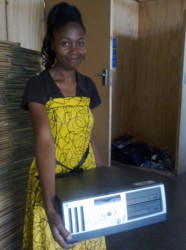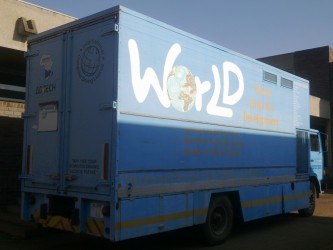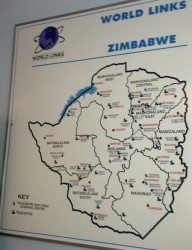Working in various developing countries for a long time (I've been overseas now for around 15 years) sometimes gives me first hand evidence of how initiatives can grow and adapt over time – and often for the best.

Ten years ago I was working in the Ministry of Education in The Gambia and a VSO volunteer colleague was ripping his hair out in frustration. He had just returned from the docks where a consignment of old computers 'donated' for African schools had arrived. Most were complete junk unsuitable even to cannibalize for parts. At best the stuff could end up in a backstreet African dump, which creates toxic hazards as the plastics are burnt off to salvage various components, wire or your bank details left on the hard disk!
An initiative originating from the World Bank, called World Links, was supporting the establishment of secondary school computer classrooms, but even to get this working in 15 Gambian senior secondary schools was a real headache. Telephones hardly worked and the mains power came on so rarely that expensive solar solutions or generator sets were being proposed, which doubled the overall costs.

A decade has passed and the World Links project finished in 2004. However the concept has evolved into an innovative and independent set of country units. These units work to provide schools in developing countries with capacity building in school ICT and self-sustaining computer labs. I came across World Links Zimbabwe Trust (WLZT) when my office in Harare wanted to clear out its old desktop computers and I contacted the Director, Mr. Eli Gudza.
A professional proposal was quickly presented to use the equipment for a computer lab in a poor neighbourhood on the edge of Harare. The next day the equipment was taken away for testing, refurbishment and installation of free software, courtesy of major vendors. Intrigued, I visited WLZT's office and workshops situated in the grounds of the University of Zimbabwe complex. Outside was parked the huge 'Big Blue' mobile IT classroom truck, that tours the country complete with its own generator to provide computer training in rural schools.

Inside the workshop I was greeted by the friendly and enthusiastic team of technicians - Gladman, Ephraim and Sipho - who were busy at work on the equipment. Stacks of second-hand computers, screens and printers filled the rooms – a virtual Aladdin's cave.
The printer graveyard was striking. Most inkjet models are worthless as the cost of replacement cartridges are prohibitive. Flat screens also raised a grumble as they have a much shorter life span than the big clunky cathode ray tube units. Computers donated from both the EU Delegation and DFID country offices were pointed out, other computers come in bulk from Europe, in what is clearly a growth industry.

Organisations based in the UK and Brussels such as Computers 4 Africa, Close the Gap and I.T. Schools Africa have emerged in the last few years. Schemes vary but the model is to collect domestic and corporate computers that become obsolete as people upgrade every 3 - 4 years. Check they work, scrub off any data and ship to a partner in Africa such as WLZT.
Already WLZT have established 45 school and community based dual-purpose 'tele-centres'. These centres are open to students and teachers during normal school hours, and the community after hours and during weekend. The Computers for Zimbabwean Schools Trust initiative makes sure the donated computers are past on 'at cost' to schools: around $150 for a more recent dual core PC with flat screen or as little as $30 for an older Pentium IV model. These prices are very competitive, even in comparison to recent global initiatives such as 'One Laptop per Child' that aim for a mass produced, stripped down low cost computer.

It will be interesting to see what direction global trends go with these initiatives to bridge the digital divide. The last decade has seen enormous progress but financial constraints, among others, remain. In Zimbabwe our recent focus has been trying to provide 'textbooks for all' at unit costs of around $1 per child and many other needs compete. Currently plans are being made for large volumes of textbooks to be given to secondary school students, using cost savings from the primary textbook procurement.
Lack of power, and low cost internet access and software are also serious obstacles as the WLZT staff described to me: while the computers may be one tenth of a new model, a monthly internet connection is roughly ten times the price in digitally connected Europe.
Without internet all those free web based e-learning tools and content are still in effect unavailable. Perhaps free content on a CD which can then be pre-loaded onto the computers arriving in Africa could be another way to promote learning.

4 comments
Comment by Laura Chattington posted on
I am really interested in your experiences regarding internet access and computers in developing countries.
I am from the marketing and IT world and I have thought about communications projects between developing countries and the western world and how to bring them together and supporting each other via the internet.
How does the Internet and the developing countries work at the moment. You mention in your article that it is very expensive. Are there any plans to improve connectivity? I have no experience of the 3rd world. If there were free CD content available could it travel back and forth? What other implications are there that someone who has no experience of the life and politics of 3rd world countries.
I would appreciate your comment on these questions if you have time.
Thanks
Comment by Eliada Gudza posted on
This is in deed an interesting write up from Ian. The commencement of the World Links For Development heralded the beginning of many national ICT in education initiatives on the African Continent in the form of SchoolNets and Tellecolaboration Partners working together to bridge the digital divide not just between North and South but as a South-South phenomenon as well. But like any of these technologically driven innovations, the hype always levels off and the real impact comes in the subsequent period of enlightenment of sustainable modeling and implementation.
World Links Zimbabwe could be seen as one such result. Despite the hardships Zimbabwe has gone through, the World Links programme has basically thrived and so have been the 50 plus centres established during the funded period.
Today WLZ is working with its partners to improve access to ICT resources by distributing good quality Refurb PCs and at the same time address digital content generation. In all this Internet connectivity costs remain the biggest challenge for schools. In order to alleviate the shortage of textbooks we must promote access to e-books and audio books and other electronic content hence computers, laptops etc must be available in schools and homes.
That is what we are trying to do.
The gesture by EU is most welcome especially when an organization hands over working usinits rather than obsolete ones.
Comment by Ian Attfield posted on
There are lots of initiatives to improve Internet access in Africa and ICT in general is spreading rapidly. However its overall affordability still prevents access for many and the costs associated make some modern Western applications unvialbe at the present time.
Comment by Chris posted on
The Digital divide is setting back the development especially in sub Sahara Africa, where ICT infrastructure is not visible. I am presently running an NGO called Information Technology Initiative for Community Development. (ITI4CD) to see where how we can bridge this unfortunate gap especially in the rural community in Africa.